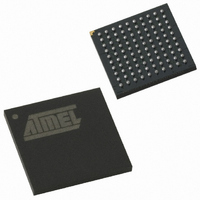AT89C51SND2C-7FTUL Atmel, AT89C51SND2C-7FTUL Datasheet - Page 184

AT89C51SND2C-7FTUL
Manufacturer Part Number
AT89C51SND2C-7FTUL
Description
IC 8051 MCU FLASH 64K MP3 100BGA
Manufacturer
Atmel
Series
89Cr
Datasheet
1.AT89C51SND2C-7FTUL.pdf
(242 pages)
Specifications of AT89C51SND2C-7FTUL
Core Processor
8051
Core Size
8-Bit
Speed
40MHz
Connectivity
I²C, IDE/ATAPI, MMC, SPI, UART/USART, USB
Peripherals
Audio, I²S, MP3, PCM, POR, WDT
Number Of I /o
32
Program Memory Size
64KB (64K x 8)
Program Memory Type
FLASH
Ram Size
2.25K x 8
Voltage - Supply (vcc/vdd)
2.7 V ~ 3.3 V
Data Converters
A/D 2x10b; D/A 2x20b
Oscillator Type
Internal
Operating Temperature
-40°C ~ 85°C
Package / Case
100-TFBGA
Data Bus Width
8 bit
Data Ram Size
2.25 KB
Interface Type
ATAPI, I2S, IDE, SPI, UART, USB
Maximum Clock Frequency
40 MHz
Number Of Programmable I/os
32
Number Of Timers
2
Maximum Operating Temperature
+ 85 C
Mounting Style
SMD/SMT
Minimum Operating Temperature
- 40 C
Lead Free Status / RoHS Status
Lead free / RoHS Compliant
Eeprom Size
-
Lead Free Status / Rohs Status
Details
Other names
AT89C51SND2C7FTUL
Available stocks
Company
Part Number
Manufacturer
Quantity
Price
Company:
Part Number:
AT89C51SND2C-7FTUL
Manufacturer:
ATMEL
Quantity:
4 371
- Current page: 184 of 242
- Download datasheet (3Mb)
21.1.4
21.1.5
184
AT8xC51SND2C/MP3B
Slave Receiver Mode
Slave Transmitter Mode
When the slave address and the direction bit have been transmitted and an acknowledgment bit
has been received, the serial interrupt flag is set again and a number of status code in SSSTA
are possible. There are 40h, 48h or 38h for the master mode and also 68h, 78h or B0h if the
slave mode was enabled (SSAA = logic 1). The appropriate action to be taken for each of these
status code is detailed in Table 21-6. This scheme is repeated until a STOP condition is
transmitted.
SSPE and SSCR2:0 are not affected by the serial transfer and are not referred to in Table 21-6.
After a repeated START condition (state 10h) the controller may switch to the master transmitter
mode by loading SSDAT with SLA+W.
In the slave receiver mode, a number of data Bytes are received from a master transmitter (see
Figure 21-5). To initiate the slave receiver mode, SSADR and SSCON must be loaded as
follows:
The upper 7 bits are the addresses to which the controller will respond when addressed by a
master. If the LSB (SSGC) is set, the controller will respond to the general call address (00h);
otherwise, it ignores the general call address.
SSCR2:0 have no effect in the slave mode. SSPE must be set to enable the controller. The
SSAA bit must be set to enable the own slave address or the general call address acknowledg-
ment. SSSTA, SSSTO and SSI must be cleared.
When SSADR and SSCON have been initialized, the controller waits until it is addressed by its
own slave address followed by the data direction bit which must be logic 0 (W) for operating in
the slave receiver mode. After its own slave address and the W bit has been received, the serial
interrupt flag is set and a valid status code can be read from SSSTA. This status code is used to
vector to an interrupt service routine, and the appropriate action to be taken for each of these
status code is detailed in Table 21-6 and Table 21-6. The slave receiver mode may also be
entered if arbitration is lost while the controller is in the master mode (see states 68h and 78h).
If the SSAA bit is reset during a transfer, the controller will return a not acknowledge (logic 1) to
SDA after the next received data Byte. While SSAA is reset, the controller does not respond to
its own slave address. However, the TWI bus is still monitored and address recognition may be
resumed at any time by setting SSAA. This means that the SSAA bit may be used to temporarily
isolate the controller from the TWI bus.
In the slave transmitter mode, a number of data Bytes are transmitted to a master receiver (see
Figure 21-6). Data transfer is initialized as in the slave receiver mode. When SSADR and
SSCON have been initialized, the controller waits until it is addressed by its own slave address
followed by the data direction bit which must be logic 1 (R) for operating in the slave transmitter
mode. After its own slave address and the R bit have been received, the serial interrupt flag is
set and a valid status code can be read from SSSTA. This status code is used to vector to an
interrupt service routine, and the appropriate action to be taken for each of these status code is
detailed in Table 21-6. The slave transmitter mode may also be entered if arbitration is lost while
the controller is in the master mode (see state B0h).
←
SSCR2
SSA6
X
SSA5
SSPE
1
SSSTA
SSA4
0
Own Slave Address
SSSTO
SSA3
0
SSA2
SSI
0
→
SSA1
SSAA
1
SSCR1
SSA0
X
4341H–MP3–10/07
SSCR0
SSGC
X
X
Related parts for AT89C51SND2C-7FTUL
Image
Part Number
Description
Manufacturer
Datasheet
Request
R

Part Number:
Description:
DEV KIT FOR AVR/AVR32
Manufacturer:
Atmel
Datasheet:

Part Number:
Description:
INTERVAL AND WIPE/WASH WIPER CONTROL IC WITH DELAY
Manufacturer:
ATMEL Corporation
Datasheet:

Part Number:
Description:
Low-Voltage Voice-Switched IC for Hands-Free Operation
Manufacturer:
ATMEL Corporation
Datasheet:

Part Number:
Description:
MONOLITHIC INTEGRATED FEATUREPHONE CIRCUIT
Manufacturer:
ATMEL Corporation
Datasheet:

Part Number:
Description:
AM-FM Receiver IC U4255BM-M
Manufacturer:
ATMEL Corporation
Datasheet:

Part Number:
Description:
Monolithic Integrated Feature Phone Circuit
Manufacturer:
ATMEL Corporation
Datasheet:

Part Number:
Description:
Multistandard Video-IF and Quasi Parallel Sound Processing
Manufacturer:
ATMEL Corporation
Datasheet:

Part Number:
Description:
High-performance EE PLD
Manufacturer:
ATMEL Corporation
Datasheet:

Part Number:
Description:
8-bit Flash Microcontroller
Manufacturer:
ATMEL Corporation
Datasheet:

Part Number:
Description:
2-Wire Serial EEPROM
Manufacturer:
ATMEL Corporation
Datasheet:











